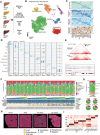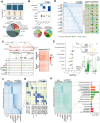This is a preprint.
Single cell multiomics reveals drivers of metabolic dysfunction-associated steatohepatitis
- PMID: 40385416
- PMCID: PMC12083587
- DOI: 10.1101/2025.05.09.25327043
Single cell multiomics reveals drivers of metabolic dysfunction-associated steatohepatitis
Abstract
Metabolic dysfunction-associated steatotic liver disease (MASLD) has limited treatments, and cell type-specific regulatory networks driving MASLD represent therapeutic avenues. We assayed five transcriptomic and epigenomic modalities in 2.4M cells from 86 livers across MASLD stages. Integrating modalities increased annotation of the genome in liver cell types several-fold over previous catalogs. We identified cell type regulatory networks of MASLD progression, including distinct hepatocyte networks driving MASL and mild and severe fibrosis MASH. Our single cell atlas annotated 88% of MASH-associated loci, including a third affecting hepatocyte regulation which we linked to distal target genes. Finally, we characterized hepatocyte heterogeneity, including MASH-enriched populations with altered repression, localization, and signaling. Overall, our results provide high-resolution maps of liver cell types and revealed novel targets for anti-MASH therapy.
Conflict of interest statement
Competing interests: K.J.G. has done consulting for Genentech, holds stock in Neurocrine biosciences, and has received honoraria from Pfizer. B.R. is a co-founder of Epigenome Technologies and has equity in Arima Genomics inc. R.M.E. is an employee and shareholder of Pfizer.
Figures





References
-
- Kisseleva T., Brenner D., Molecular and cellular mechanisms of liver fibrosis and its regression. Nat Rev Gastroenterol Hepatol 18, 151–166 (2021). - PubMed
-
- Lieber C. S., Rubin E., DeCarli L. M., Hepatic microsomal ethanol oxidizing system (MEOS): differentiation from alcohol dehydrogenase and NADPH oxidase. Biochem Biophys Res Commun 40, 858–865 (1970). - PubMed
-
- Riazi K., Azhari H., Charette J. H., Underwood F. E., King J. A., Afshar E. E., Swain M. G., Congly S. E., Kaplan G. G., Shaheen A.-A., The prevalence and incidence of NAFLD worldwide: a systematic review and meta-analysis. Lancet Gastroenterol Hepatol 7, 851–861 (2022). - PubMed
Publication types
Grants and funding
- U01 HG012059/HG/NHGRI NIH HHS/United States
- P42 ES010337/ES/NIEHS NIH HHS/United States
- P30 DK120515/DK/NIDDK NIH HHS/United States
- U01 AA029019/AA/NIAAA NIH HHS/United States
- UM1 HG011585/HG/NHGRI NIH HHS/United States
- R56 DK088837/DK/NIDDK NIH HHS/United States
- R01 DK091183/DK/NIDDK NIH HHS/United States
- R01 CA285997/CA/NCI NIH HHS/United States
- R01 DK111866/DK/NIDDK NIH HHS/United States
- R01 DK099205/DK/NIDDK NIH HHS/United States
- R01 AA028550/AA/NIAAA NIH HHS/United States
- T32 HL007444/HL/NHLBI NIH HHS/United States
- P50 AA011999/AA/NIAAA NIH HHS/United States
- T32 GM008666/GM/NIGMS NIH HHS/United States
- R01 DK101737/DK/NIDDK NIH HHS/United States
- R44 DK115242/DK/NIDDK NIH HHS/United States
LinkOut - more resources
Full Text Sources
